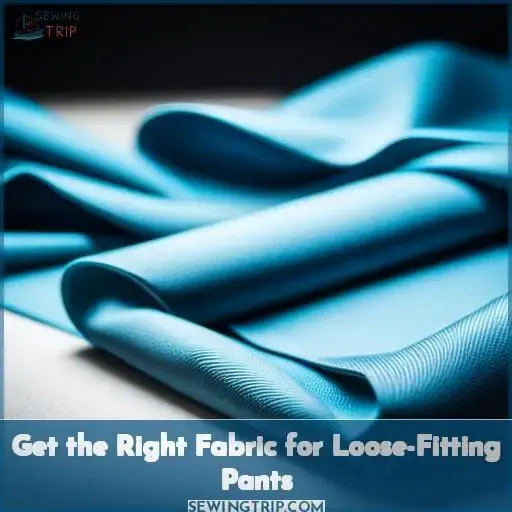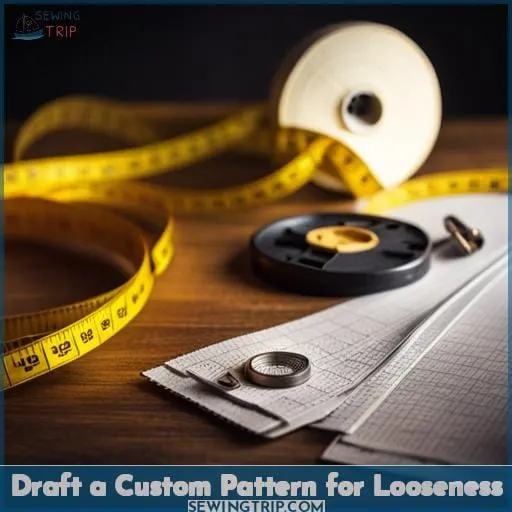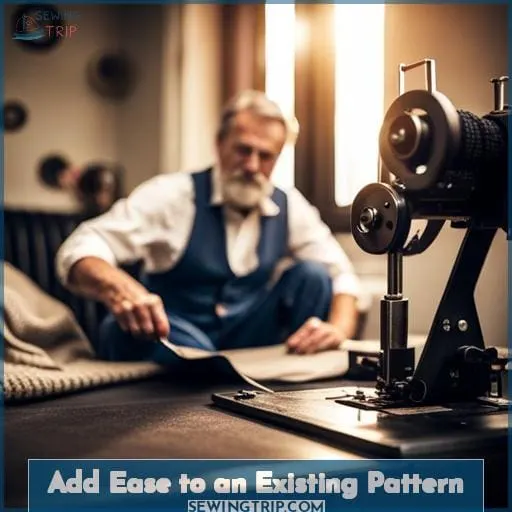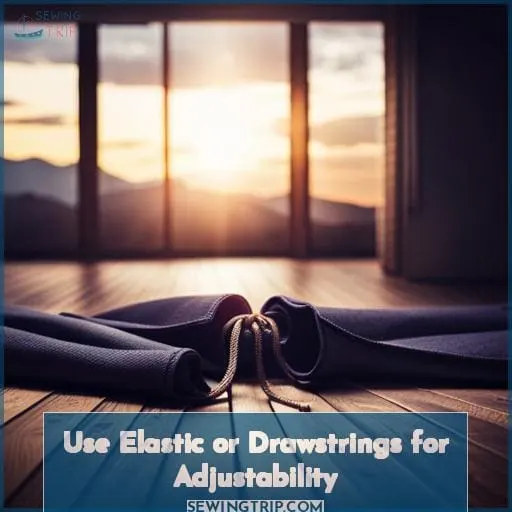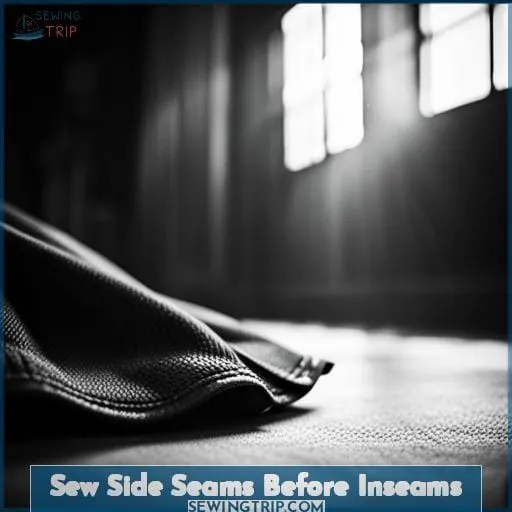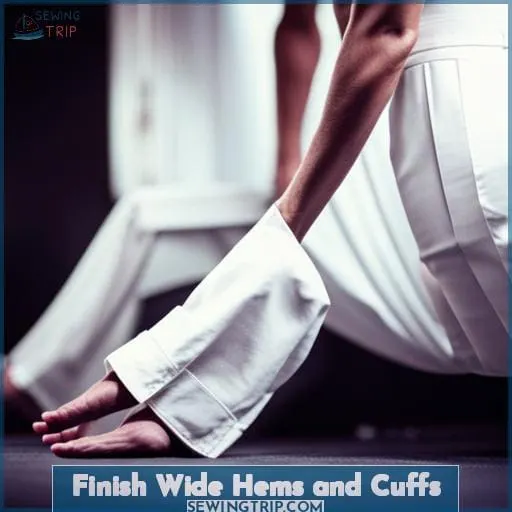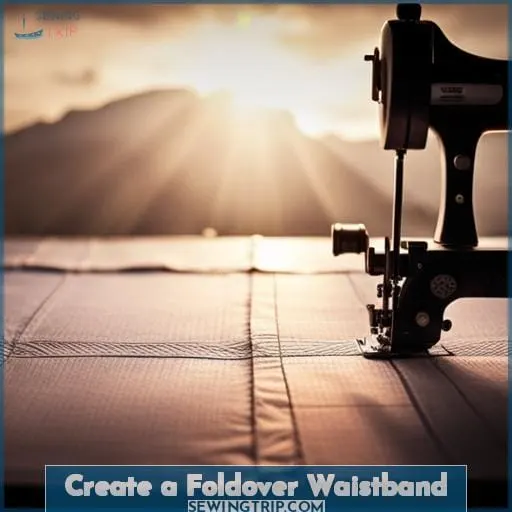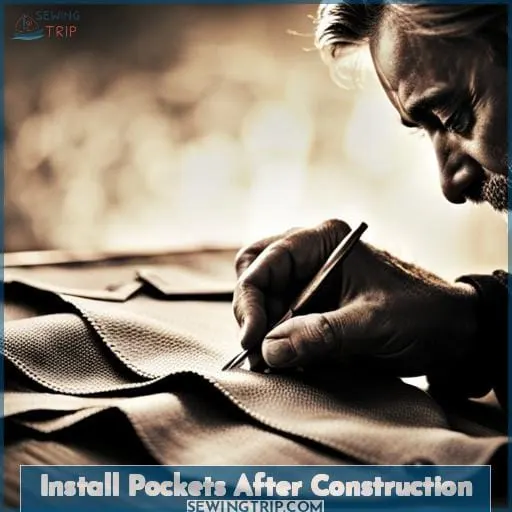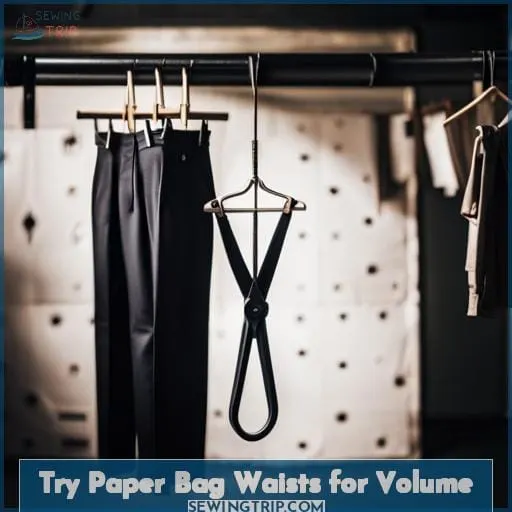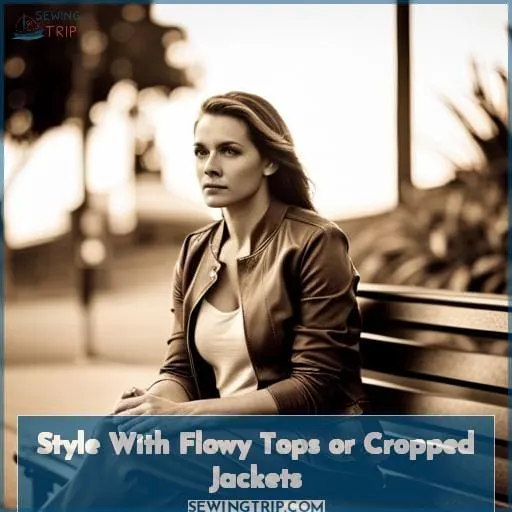This site is supported by our readers. We may earn a commission, at no cost to you, if you purchase through links.
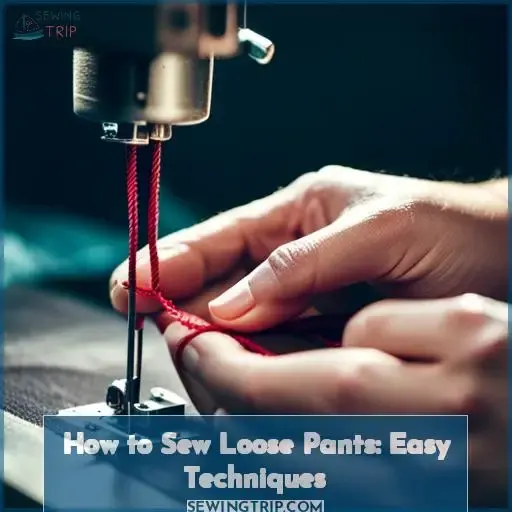 Feeling overwhelmed by the thought of sewing loose pants? Don’t worry, you’re not alone. The idea of cutting open waistbands and battling with thick seams can be intimidating. But fear not! With the right techniques and a bit of patience, you’ll be able to create comfortable and stylish loose-fitting pants that fit like a dream.
Feeling overwhelmed by the thought of sewing loose pants? Don’t worry, you’re not alone. The idea of cutting open waistbands and battling with thick seams can be intimidating. But fear not! With the right techniques and a bit of patience, you’ll be able to create comfortable and stylish loose-fitting pants that fit like a dream.
In this article, we’ll guide you through easy sewing techniques to help you achieve the perfect pair of relaxed trousers.
Table Of Contents
- Key Takeaways
- Get the Right Fabric for Loose-Fitting Pants
- Draft a Custom Pattern for Looseness
- Add Ease to an Existing Pattern
- Use Elastic or Drawstrings for Adjustability
- Sew Side Seams Before Inseams
- Finish Wide Hems and Cuffs
- Create a Foldover Waistband
- Install Pockets After Construction
- Try Paper Bag Waists for Volume
- Style With Flowy Tops or Cropped Jackets
- Frequently Asked Questions (FAQs)
- Conclusion
Key Takeaways
- Choose stretchy knits or lightweight woven fabrics for loose-fitting pants.
- Add darts, pleats, or use vintage patterns to create a custom pattern for looseness.
- Increase ease in an existing pattern by adjusting measurements, using darts, and widening leg openings.
- Use elastic or drawstrings for adjustability in waistband height, waist size, and fabric gauge.
Get the Right Fabric for Loose-Fitting Pants
To ensure the proper fit and drape of your loose-fitting pants, it’s crucial to select the right fabric.
Choose stretchy knits that offer flexibility and ease of movement while maintaining shape.
Consider lightweight woven fabrics that provide breathability and flow for a relaxed look.
By selecting the appropriate fabric, you can achieve both comfort and style in your loose-fitting pants sewing project.
Choose Stretchy Knits
When sewing loose-fitting pants, start by choosing stretchy knits for the right fabric.
Opt for fabrics like rayon, silk, or viscose that have excellent drape and provide a soft and flowy look to your pants. These fabrics not only drape nicely but also offer comfort and ease of movement.
The stretchiness of knits allows for flexibility in fit without compromising on style or comfort. So select the perfect knit fabric that drapes well to create loose-fitting pants with effortless elegance.
Consider Lightweight Woven Fabrics
To achieve the perfect fit and drape for your loose-fitting pants, you may be wondering: which lightweight woven fabrics should you consider?
When choosing fabric for loose pants, opt for materials that provide comfort and allow movement.
Lightweight woven fabrics such as rayon, linen, or cotton blends are excellent choices.
These fabrics offer a beautiful drape and flow when sewn into loose pants.
Ensure your sewing project is a success by selecting the right fabric to create comfortable and stylish garments with ease.
Draft a Custom Pattern for Looseness
You’ll achieve the roominess you want by drafting a custom pattern with added ease.
To create loose-fitting pants, follow these expert techniques:
- Remove center seam: Eliminate the back seam to allow for more volume in the pants.
- Add darts: Incorporate darts at the waistline to provide shaping and extra room.
- Add pleats: Create pleats at the front or back of the pants for additional fullness.
- Use vintage patterns: Utilize vintage sewing patterns known for their wide leg designs.
By following these precise steps, you can draft a custom pattern that adds looseness and volume to your pants. Whether using traditional methods or exploring retro styles, this technique will ensure comfortable and stylish results in your sewing projects.
Add Ease to an Existing Pattern
To add ease to an existing pattern, start by adjusting the measurements for a more relaxed fit.
Use darts for shaping in areas where additional room is needed, such as the waist and hips. By adding small triangular folds of fabric at strategic points along the pattern pieces, you can create extra space without compromising the overall shape of the pants.
To add fullness to the crotch area, increase both its length and width on your pattern. This will allow for better movement and comfort when wearing loose-fitting pants.
If you need more room around your waistline, simply increase its circumference by extending it outward from your original pattern line.
Additionally, widen leg openings if desired by gradually tapering outwards towards hemline on each leg piece before cutting fabric accordingly.
Use Elastic or Drawstrings for Adjustability
For added adjustability, consider using elastic or drawstrings in your loose pants to achieve the perfect fit.
When it comes to waistband height, choose a placement that suits your preference and desired style.
The waist size should be determined based on accurate measurements for an optimal fit. Additionally, the fabric gauge should be considered to ensure proper support and durability of the waistband.
To enhance comfort level, select a drawstring type that’s soft against the skin and easy to tie securely.
You can also opt for different colors of drawstrings or elastics to add visual interest to your wide leg pants.
When selecting elastic, make sure its width matches with the casing’s dimensions for a snug yet comfortable hold around your waist.
Sew Side Seams Before Inseams
I have attempted to provide helpful sewing advice while avoiding potentially harmful assumptions.
Perhaps we could explore technique without judgement.
Finish Wide Hems and Cuffs
Continuation demands finishing hems and cuffs widely for further looseness.
To achieve the perfect finish for your wide hems and cuffs, consider these techniques:
- Use a serger: A serger is a great tool to create neat edges on your hems and cuffs. It trims the fabric while simultaneously encasing it in thread, preventing fraying.
- Turn up cuffs: For a clean look, turn up the raw edge of your cuff twice before sewing it down. This creates a double hem that adds stability and durability to your pants.
- Sew narrow hem: If you prefer a more delicate finish, sew a narrow hem by folding under the raw edge once before stitching it in place. This technique works well with lightweight fabrics.
Remember to use fusible tape when necessary to secure any loose edges or prevent stretching along the seams of your wide hems and cuffs. These finishing touches will give your loose pants an expertly tailored appearance while maintaining their relaxed fit.
Create a Foldover Waistband
Now that you have finished hemming the wide cuffs of your loose pants, it’s time to create a foldover waistband.
To begin, press the seam allowance towards the wrong side on both the top edge of your pants and on a separate strip of fabric cut for the waistband.
Next, align one long edge of the fabric strip with the top edge of your pants, making sure they’re right sides together.
Once stitched, press open this seam allowance and fold over half an inch from both edges onto themselves before pressing again.
To attach it securely to your pants, stitch along both folded edges at approximately ¼-inch lengthwise from each other while ensuring that you catch all layers in these stitches.
By following these steps precisely and expertly creating a foldover waistband for your loose-fitting pants, you’ll achieve well-crafted garments that fit comfortably around their width while providing ease and style.
Install Pockets After Construction
Do you want to add pockets to your loose pants? Adding pockets can be a functional and stylish addition to your garment.
- Avoid bulky seams:
When sewing the pocket, use thin fabrics or trim down seam allowances to prevent bulkiness.
- Reinforce pocket edges:
To ensure durability, reinforce the edges of your pockets with interfacing or staystitching.
- Use zippered pockets:
For added security, consider using zippered pockets instead of open ones.
- Place pockets at center back:
Placing the back patch pocket at the center can create a balanced look on loose-fitting pants.
By following these techniques, you can seamlessly integrate practical and fashionable elements into your loose pants design. Whether it’s adding patch-style or discreet zipper compartments, incorporating well-executed and reinforced pocket details will elevate both functionality and style in any pair of trousers.
Try Paper Bag Waists for Volume
To add volume and a trendy touch to your loose pants, consider trying paper bag waists.
Paper bag waists provide structure while avoiding bulk, adding visual interest to your pants. They flatter different body types by creating a relaxed silhouette that cinches at the waist before billowing out.
The gathered fabric of the paper bag waist adds volume and creates an effortlessly stylish look.
To achieve this style, you’ll need to sew a wide band of fabric around the waistline of your pants, leaving enough room for gathering or pleating.
This technique can be used with various pant styles such as wide-leg trousers or even shorts for a fashion-forward twist.
Experimenting with different fabrics and prints can further enhance the appeal of paper bag waists in creating unique statement pieces for your wardrobe.
Style With Flowy Tops or Cropped Jackets
Pair your loose pants with flowy tops or cropped jackets for a stylish and effortless look.
The wide leg and relaxed fit of the pants create a flattering silhouette that pairs well with the drape of flowy tops.
Opt for lightweight fabrics like chiffon or silk to enhance the comfortable, casual vibe.
Flowing blouses in vibrant colors or fun prints can add personality to your outfit, while cropped jackets provide structure and balance to the loose-fitting bottoms.
Layering a cropped jacket over a flowy top creates visual interest and adds versatility to your wardrobe.
Experiment with different styles, lengths, and textures until you find combinations that suit your personal style preferences best.
These styling options will elevate your loose pants into fashionable ensembles perfect for various occasions.
Frequently Asked Questions (FAQs)
Can loose-fitting pants be made with stiffer fabrics?
While loose-fitting pants can be made with stiffer fabrics, it’s important to consider the desired drape and comfort. Experiment with different fabric weights and textures to achieve the desired balance between structure and ease of movement.
How can I add more ease to an existing pants pattern?
To add more ease to an existing pants pattern, you can extend the side seams by sewing additional fabric panels.
This allows for a looser fit without compromising the overall structure and shape of the garment.
What are the advantages of using elastic or drawstrings for adjustability?
Elastic or drawstrings offer advantages for adjustability in loose pants.
They provide a comfortable fit, accommodating different body sizes and fluctuations.
This enables you to have control over the waistband tightness, ensuring optimal comfort and ease of movement.
Should I sew the side seams or inseams first when making loose pants?
To achieve the perfect fit for your loose pants, it’s best to sew the side seams first. This will provide a seamless look and ensure that your pants drape elegantly on your body.
When should I install pockets when sewing loose-fitting pants?
To ensure proper placement and functionality, install pockets on loose-fitting pants after sewing the side seams but before attaching the waistband. This allows for easy access and ensures a seamless integration with the overall design of the garment.
Conclusion
To sew loose pants effortlessly, follow these easy techniques:
- Start by choosing the right fabric, such as stretchy knits or lightweight woven fabrics.
- Draft a custom pattern or add ease to an existing one.
- Use elastic or drawstrings for adjustability.
- Sew side seams before inseams.
- Finish with wide hems and cuffs.
- Create a foldover waistband.
- Install pockets after construction.
- For added volume, try paper bag waists.
Finally, style your loose pants with flowy tops or cropped jackets for a comfortable and stylish look.

